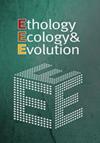种虫性选择的机会和强度取决于寄主植物的分散程度
IF 1.3
4区 生物学
Q4 BEHAVIORAL SCIENCES
引用次数: 1
摘要
在乔治亚州(美国)沿海平原的田野里,一种名为bicrucis的种子虫,专门以苦苣苔为食并交配。ragwort, Senecio tomentosus的分布要么是分散的,少量植物分布在大片地区,要么是聚集的,大量植物集中在相对较小的地区。在分散生境中,种虫密度低(< 20/0.25 m2),成虫交配比例低(20%)。在群集生境中,成虫密度有时很高(30-75/0.25 m2),交配率也很高(约67%)。在这两个栖息地中,交配的雄性比非交配的雄性处于更好的状态(=质量-长度预期质量)。在群集的栖息地中,雄性之间的攻击频繁发生,并决定了在高度丰富的区域居住,在那里雌性特别吸引交配和产卵。一项重新捕获标记的研究表明,雄性在分散的栖息地比聚集的栖息地移动得更多,可能是为了寻找配偶。在分散生境中,雄性交配效率(交配次数/目击次数)的方差符合随机预期,但显著高于聚集生境,表明有更大的性选择机会。利用标记重获数据对选择强度进行的多变量分析显示,在分散的栖息地,翅膀较长、身体较短的鸟类更受青睐,这表明选择是基于寻找配偶的能力。在群集的栖息地,选择倾向于较长的身体、触角和腿。这一发现表明,在侵略性的相互作用中,选择倾向于优势,因为腿和触角用于与对手搏斗,并在侵略性的求爱过程中抓住雌性。本文章由计算机程序翻译,如有差异,请以英文原文为准。
The opportunity for and intensity of sexual selection in a seed bug depend on host plant dispersion
In fields of the coastal plain of Georgia (USA), the seed bug, Neacoryphus bicrucis, feeds and mates exclusively on ragwort. The distribution of ragwort, Senecio tomentosus, is either dispersed, with small numbers of plants spread over large areas, or clustered, with large numbers of plants concentrated into relatively small areas. In dispersed habitat, the density of seed bugs is always low (< 20/0.25 m2) as is the proportion of adults who are mating (20%). In clustered habitat, adult densities are occasionally high (30–75/0.25 m2) as are mating rates (> 67%). In both habitats, mating males are in better condition (= mass – mass expected from length) than non-mating males. In clustered habitats, aggression between males occurs frequently and determines residency in areas of high ragwort abundance to which females are especially attracted for mating and oviposition. A mark-recapture study revealed that males move about more in dispersed than clustered habitats, possibly searching for mates. Variance in male mating efficiency (copulations/sightings) matches random expectations in dispersed habitats but is significantly higher than that in clustered habitats, suggesting greater opportunity for sexual selection. A multivariate analysis of selection intensity using mark-recapture data revealed that longer wings and shorter bodies are favored in dispersed habitat, suggesting selection on ability to search for mates. In clustered habitat, selection favors a longer body, antennae, and legs. This finding suggests selection favoring dominance in aggressive interactions, as legs and antennae are used to grapple with opponents and to seize females during aggressive courtship.
求助全文
通过发布文献求助,成功后即可免费获取论文全文。
去求助
来源期刊

Ethology Ecology & Evolution
生物-动物学
CiteScore
3.10
自引率
0.00%
发文量
44
审稿时长
>12 weeks
期刊介绍:
Ethology Ecology & Evolution is an international peer reviewed journal which publishes original research and review articles on all aspects of animal behaviour, ecology and evolution. Articles should emphasise the significance of the research for understanding the function, ecology, evolution or genetics of behaviour. Contributions are also sought on aspects of ethology, ecology, evolution and genetics relevant to conservation.
Research articles may be in the form of full length papers or short research reports. The Editor encourages the submission of short papers containing critical discussion of current issues in all the above areas. Monograph-length manuscripts on topics of major interest, as well as descriptions of new methods are welcome. A Forum, Letters to Editor and Book Reviews are also included. Special Issues are also occasionally published.
 求助内容:
求助内容: 应助结果提醒方式:
应助结果提醒方式:


